#Frankish or European
Photo

Frankish or European
Pera, contiguous to Galata, and on the heights rising immediately above it, is the Frankish or European, quarter of the city, where the Europeans, Levantines, and a great part of the Greek and Armenian population live, and where all the hotels and the foreign embassies and consulates are situated.
Kassim Pasha is a filthy and insanitary suburb in the immediate vicinity of the dockyard, off which the Turkish fleet lies at anchor throughout the year. The fine marble building standing on a plot of land jutting out into the Golden Horn is the Admiralty. Close by are the graving-docks, slips, building sheds, and workshops, where, until recently, a considerable number of British foremen, mostly Scotchmen, were employed. The large building on the hill, immediately above the dockyard, is the Naval Hospital.
Kassim Pasha
Phanar, now a dirty and poor-looking suburb, lies on the Stambul side, opposite Kassim Pasha, and is chiefly inhabited by Greeks. Its name Phanarion, shortened by the Turks into Phanar or Phener, is a diminutive of javo; (a lantern).
Phanar is the seat of the Patriarch, the head of the Eastern or Greek Church; and here is situated the Greek Cathedral of St. George, in connection with the Patriarch’s residence. Travellers are freely admitted to the different rooms of the Patriarch’s official residence, in one of which visitors are shown a painting representing Sultan Muhammad II., the Conqueror, in his state robes, handing the patriarch Gennadius Scholarius the the river Vorvyses.
The mouth of the latter, called Kara Agatch, is the point where the steamers stop. The valley of the Sweet Waters of Europe is a favourite resort of natives, especially Turks, in spring and early summer, and can be reached by water, or by carriage from Pera. The better class of people, and ladies, always drive there. Travellers desirous of getting a glimpse of Turkish life should visit the spot on a fine Friday afternoon in spring. A good plan is to drive there from Pera and return by water, or vice versa. No Turkish ladies are to be seen there in Ramazan.
0 notes
Photo

Frankish or European
Pera, contiguous to Galata, and on the heights rising immediately above it, is the Frankish or European, quarter of the city, where the Europeans, Levantines, and a great part of the Greek and Armenian population live, and where all the hotels and the foreign embassies and consulates are situated.
Kassim Pasha is a filthy and insanitary suburb in the immediate vicinity of the dockyard, off which the Turkish fleet lies at anchor throughout the year. The fine marble building standing on a plot of land jutting out into the Golden Horn is the Admiralty. Close by are the graving-docks, slips, building sheds, and workshops, where, until recently, a considerable number of British foremen, mostly Scotchmen, were employed. The large building on the hill, immediately above the dockyard, is the Naval Hospital.
Kassim Pasha
Phanar, now a dirty and poor-looking suburb, lies on the Stambul side, opposite Kassim Pasha, and is chiefly inhabited by Greeks. Its name Phanarion, shortened by the Turks into Phanar or Phener, is a diminutive of javo; (a lantern).
Phanar is the seat of the Patriarch, the head of the Eastern or Greek Church; and here is situated the Greek Cathedral of St. George, in connection with the Patriarch’s residence. Travellers are freely admitted to the different rooms of the Patriarch’s official residence, in one of which visitors are shown a painting representing Sultan Muhammad II., the Conqueror, in his state robes, handing the patriarch Gennadius Scholarius the the river Vorvyses.
The mouth of the latter, called Kara Agatch, is the point where the steamers stop. The valley of the Sweet Waters of Europe is a favourite resort of natives, especially Turks, in spring and early summer, and can be reached by water, or by carriage from Pera. The better class of people, and ladies, always drive there. Travellers desirous of getting a glimpse of Turkish life should visit the spot on a fine Friday afternoon in spring. A good plan is to drive there from Pera and return by water, or vice versa. No Turkish ladies are to be seen there in Ramazan.
0 notes
Photo
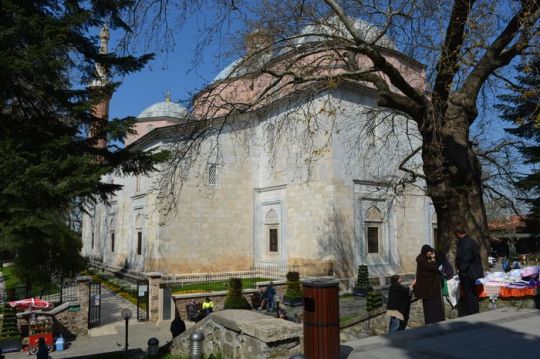
Frankish or European
Pera, contiguous to Galata, and on the heights rising immediately above it, is the Frankish or European, quarter of the city, where the Europeans, Levantines, and a great part of the Greek and Armenian population live, and where all the hotels and the foreign embassies and consulates are situated.
Kassim Pasha is a filthy and insanitary suburb in the immediate vicinity of the dockyard, off which the Turkish fleet lies at anchor throughout the year. The fine marble building standing on a plot of land jutting out into the Golden Horn is the Admiralty. Close by are the graving-docks, slips, building sheds, and workshops, where, until recently, a considerable number of British foremen, mostly Scotchmen, were employed. The large building on the hill, immediately above the dockyard, is the Naval Hospital.
Kassim Pasha
Phanar, now a dirty and poor-looking suburb, lies on the Stambul side, opposite Kassim Pasha, and is chiefly inhabited by Greeks. Its name Phanarion, shortened by the Turks into Phanar or Phener, is a diminutive of javo; (a lantern).
Phanar is the seat of the Patriarch, the head of the Eastern or Greek Church; and here is situated the Greek Cathedral of St. George, in connection with the Patriarch’s residence. Travellers are freely admitted to the different rooms of the Patriarch’s official residence, in one of which visitors are shown a painting representing Sultan Muhammad II., the Conqueror, in his state robes, handing the patriarch Gennadius Scholarius the the river Vorvyses.
The mouth of the latter, called Kara Agatch, is the point where the steamers stop. The valley of the Sweet Waters of Europe is a favourite resort of natives, especially Turks, in spring and early summer, and can be reached by water, or by carriage from Pera. The better class of people, and ladies, always drive there. Travellers desirous of getting a glimpse of Turkish life should visit the spot on a fine Friday afternoon in spring. A good plan is to drive there from Pera and return by water, or vice versa. No Turkish ladies are to be seen there in Ramazan.
0 notes
Photo

Frankish or European
Pera, contiguous to Galata, and on the heights rising immediately above it, is the Frankish or European, quarter of the city, where the Europeans, Levantines, and a great part of the Greek and Armenian population live, and where all the hotels and the foreign embassies and consulates are situated.
Kassim Pasha is a filthy and insanitary suburb in the immediate vicinity of the dockyard, off which the Turkish fleet lies at anchor throughout the year. The fine marble building standing on a plot of land jutting out into the Golden Horn is the Admiralty. Close by are the graving-docks, slips, building sheds, and workshops, where, until recently, a considerable number of British foremen, mostly Scotchmen, were employed. The large building on the hill, immediately above the dockyard, is the Naval Hospital.
Kassim Pasha
Phanar, now a dirty and poor-looking suburb, lies on the Stambul side, opposite Kassim Pasha, and is chiefly inhabited by Greeks. Its name Phanarion, shortened by the Turks into Phanar or Phener, is a diminutive of javo; (a lantern).
Phanar is the seat of the Patriarch, the head of the Eastern or Greek Church; and here is situated the Greek Cathedral of St. George, in connection with the Patriarch’s residence. Travellers are freely admitted to the different rooms of the Patriarch’s official residence, in one of which visitors are shown a painting representing Sultan Muhammad II., the Conqueror, in his state robes, handing the patriarch Gennadius Scholarius the the river Vorvyses.
The mouth of the latter, called Kara Agatch, is the point where the steamers stop. The valley of the Sweet Waters of Europe is a favourite resort of natives, especially Turks, in spring and early summer, and can be reached by water, or by carriage from Pera. The better class of people, and ladies, always drive there. Travellers desirous of getting a glimpse of Turkish life should visit the spot on a fine Friday afternoon in spring. A good plan is to drive there from Pera and return by water, or vice versa. No Turkish ladies are to be seen there in Ramazan.
0 notes
Text
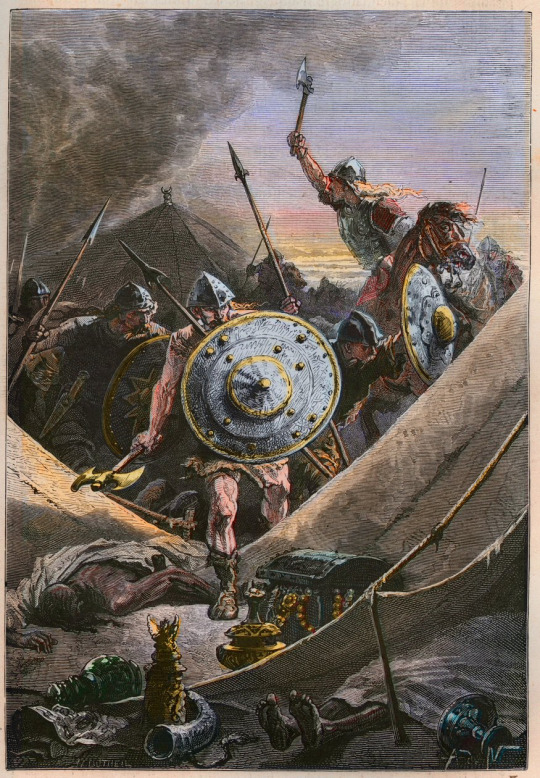
Attack on a Moorish camp - Defeat of the Saracens at the Battle of Tours, AD 732 — by Alphonse de Neuville
The Franks led by Charles Martel attack the Saracen camp at the Battle of Tours, halting the Muslim invasion in the year 732
#charles martel#battle of tours#battle of poitiers#franks#frankish#moors#invasion#germanic#france#art#alphonse de neuville#history#middle ages#medieval#europe#european#islam#muslim#christian#christianity#tent#battle#civilisation#civilization#western civilization#western civilisation#western europe#alphonse marie adolphe de neuville#french#treasure
171 notes
·
View notes
Text
Some nations and their birth/death date
- Britannia : born around 800BCE (beginning of British Iron Age); died around 500CE, but she had been getting weaker ever since Rome's forces left.
- Rome : born in 753BCE (Rome's fonding); died in 476CE, for obvious reasons
- Gaul (celtic) : born around 700BCE (between the Halstatt and La Tène cultures); died not long after the Gallic wars in 52BCE
- Germania : born around 750BCE (Nordic Iron Age) died not long after Rome's fall
- Frankish Kingdom/Empire: died in 843 (Treaty of Verdun), son of Germania
- Burgundian Kingdom/State: died in 1482 (end of the Burgundian War of Succession), daughter of Germania
- Frisian Kingdom: died 1523 (end or Frisian Freedom after a failed Frisian rebellion), son of Germania (and is either the biological or the adopted father of the Low Countries (or at least the Netherlands))
- France: born shortly before the Gallic Wars, son of Gaul
- England: born around 500 CE (first Anglo-Saxon kingdoms), he would fully become his "own" in 927 with the Kingdom of England, son of Britannia
- Spain: born somewhere during the Roman era, son of Rome
- Portugal: same as Spain, but earlier, son of Rome
- Netherlands: born shortly before the Roman conquest of Gaul (Belgae), son of idk who yet
- HRE: born in 486CE, when the Franks beat the Soissons Domain; died 1806 for obvious reasons, son of the Frankish Kingdom
- Middle Francia/Lotharingia: born in 843CE (Treaty of Verdun); died either 958CE (division of the Kingdom of Lotharingia) or 1190CE (Lower Lotharingia lost its territorial authority), daughter of the Frankish Kingdom
- Austrasia & Neustria: born in 511CE, died in 751CE, those boys were literally twins and they started the tradition of ✨️fratricide✨️ in the family (later carried on by France killing HRE), sons of the Frankish Kingdom
- Prussia: born 1226CE (creation of the State of the Teutonic Order)/born 1th century CE if we consider him an Old Prussian (Baltic tribe), son of how do I know
- Germany: born...1806(Confederation of the Rhine), 1815(German Confederation), 1866 (North German Confederation) or 1871 (Proclamation of the Reich)
Or he's HRE according to some... I don't know he's complicated...
#feel absolutely free to propose other dates if you don't agree or think there can be another date#very west european/germanic centred sorry :(#i have no idea when Germania's children would be born tho so uh yeah sorry#mes blogs#hetalia#historical hetalia#aph rome#aph germania#aph gaul#aph britannia#aph frankish empire#aph burgundian state#aph frisian kingdom#aph france#aph england#aph spain#aph portugal#aph netherlands#aph hre#aph lotharingia#aph austrasia#aph neustria#aph prussia#aph germany#ill stop here thanks-#hetalia headcanons
51 notes
·
View notes
Text

all RIGHT:
Why You're Writing Medieval (and Medieval-Coded) Women Wrong: A RANT
(Or, For the Love of God, People, Stop Pretending Victorian Style Gender Roles Applied to All of History)
This is a problem I see alllll over the place - I'll be reading a medieval-coded book and the women will be told they aren't allowed to fight or learn or work, that they are only supposed to get married, keep house and have babies, &c &c.
If I point this out ppl will be like "yes but there was misogyny back then! women were treated terribly!" and OK. Stop right there.
By & large, what we as a culture think of as misogyny & patriarchy is the expression prevalent in Victorian times - not medieval. (And NO, this is not me blaming Victorians for their theme park version of "medieval history". This is me blaming 21st century people for being ignorant & refusing to do their homework).
Yes, there was misogyny in medieval times, but 1) in many ways it was actually markedly less severe than Victorian misogyny, tyvm - and 2) it was of a quite different type. (Disclaimer: I am speaking specifically of Frankish, Western European medieval women rather than those in other parts of the world. This applies to a lesser extent in Byzantium and I am still learning about women in the medieval Islamic world.)
So, here are the 2 vital things to remember about women when writing medieval or medieval-coded societies
FIRST. Where in Victorian times the primary axes of prejudice were gender and race - so that a male labourer had more rights than a female of the higher classes, and a middle class white man would be treated with more respect than an African or Indian dignitary - In medieval times, the primary axis of prejudice was, overwhelmingly, class. Thus, Frankish crusader knights arguably felt more solidarity with their Muslim opponents of knightly status, than they did their own peasants. Faith and age were also medieval axes of prejudice - children and young people were exploited ruthlessly, sent into war or marriage at 15 (boys) or 12 (girls). Gender was less important.
What this meant was that a medieval woman could expect - indeed demand - to be treated more or less the same way the men of her class were. Where no ancient legal obstacle existed, such as Salic law, a king's daughter could and did expect to rule, even after marriage.
Women of the knightly class could & did arm & fight - something that required a MASSIVE outlay of money, which was obviously at their discretion & disposal. See: Sichelgaita, Isabel de Conches, the unnamed women fighting in armour as knights during the Third Crusade, as recorded by Muslim chroniclers.
Tolkien's Eowyn is a great example of this medieval attitude to class trumping race: complaining that she's being told not to fight, she stresses her class: "I am of the house of Eorl & not a serving woman". She claims her rights, not as a woman, but as a member of the warrior class and the ruling family. Similarly in Renaissance Venice a doge protested the practice which saw 80% of noble women locked into convents for life: if these had been men they would have been "born to command & govern the world". Their class ought to have exempted them from discrimination on the basis of sex.
So, tip #1 for writing medieval women: remember that their class always outweighed their gender. They might be subordinate to the men within their own class, but not to those below.
SECOND. Whereas Victorians saw women's highest calling as marriage & children - the "angel in the house" ennobling & improving their men on a spiritual but rarely practical level - Medievals by contrast prized virginity/celibacy above marriage, seeing it as a way for women to transcend their sex. Often as nuns, saints, mystics; sometimes as warriors, queens, & ladies; always as businesswomen & merchants, women could & did forge their own paths in life
When Elizabeth I claimed to have "the heart & stomach of a king" & adopted the persona of the virgin queen, this was the norm she appealed to. Women could do things; they just had to prove they were Not Like Other Girls. By Elizabeth's time things were already changing: it was the Reformation that switched the ideal to marriage, & the Enlightenment that divorced femininity from reason, aggression & public life.
For more on this topic, read Katherine Hager's article "Endowed With Manly Courage: Medieval Perceptions of Women in Combat" on women who transcended gender to occupy a liminal space as warrior/virgin/saint.
So, tip #2: remember that for medieval women, wife and mother wasn't the ideal, virgin saint was the ideal. By proving yourself "not like other girls" you could gain significant autonomy & freedom.
Finally a bonus tip: if writing about medieval women, be sure to read writing on women's issues from the time so as to understand the terms in which these women spoke about & defended their ambitions. Start with Christine de Pisan.
I learned all this doing the reading for WATCHERS OF OUTREMER, my series of historical fantasy novels set in the medieval crusader states, which were dominated by strong medieval women! Book 5, THE HOUSE OF MOURNING (forthcoming 2023) will focus, to a greater extent than any other novel I've ever yet read or written, on the experience of women during the crusades - as warriors, captives, and political leaders. I can't wait to share it with you all!
#watchers of outremer#medieval history#the lady of kingdoms#the house of mourning#writing#writing fantasy#female characters#medieval women#eowyn#the lord of the rings#lotr#history#historical fiction#fantasy#writing tip#writing advice
29K notes
·
View notes
Text
i guess robert guiscard is about as funny of a european guy as you could possibly play as but playing as any european guy is soooo boring
1 note
·
View note
Text
In reaction to this post, @irlactualwizard wrote:
This is beautiful.
On the note about maces and the like, they're traditionally horseback weaponry. I'm unsure of the usefulness or practicality of a dagger tucked away in a weapon primarily used from 'higher ground' or where CQC wouldn't be common. I mean, fall off the horse, drop the mace and draw the saber or katar.
Although, redundancy is what keeps humans alive. It does strike me as odd that they wouldn't have shoved an extra weapon in just for the niche.
That notion of dropping the mace then drawing something else with longer (or for really close quarters, shorter) reach is something which may well have happened, though not just because it was an exclusively cavalry weapon. All the other weapons were also used from horseback, and in one instance its original Indo-Persian name is pretty specific about equestrian origins.
The zaghnal, that wicked pick-axe thing...
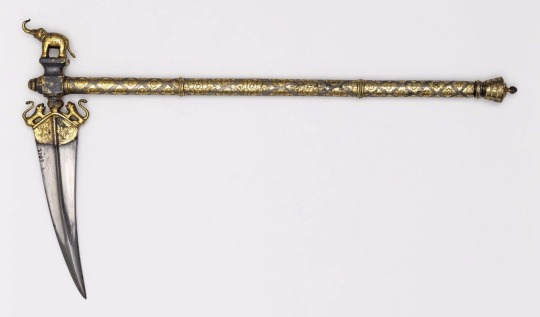
(yup, there's a dagger...)
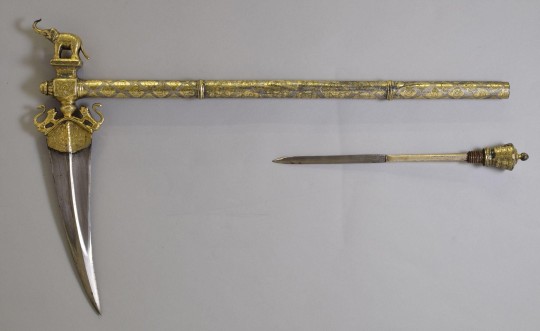
...has a European equivalent called a "horseman's pick" and supposedly copied from Ottoman weapons which would have been zaghnal-shaped; this one is Polish or Hungarian...

The hatchet-knife bhuj was - per Wikipedia, Bygone Blades and Oriental Arms - a popular weapon with the Gujarati and Sindhi cavalry, who also wore a distinctive style of full armour...
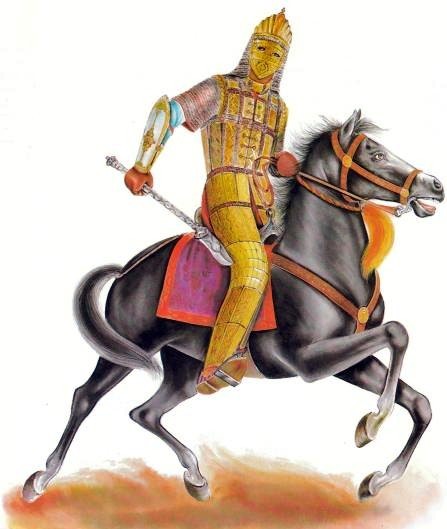
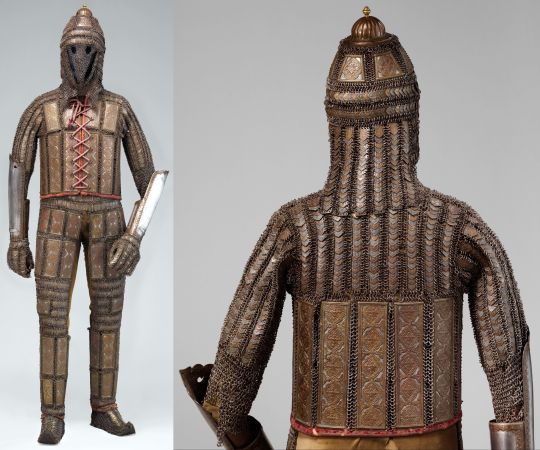

(yup, there's a dagger)

(This time there's a gun, and probably a dagger too because why not?)

Most conclusively, the proper name for Indo-Persian battleaxes is tabar / tabarzin, which means "saddle-axe".
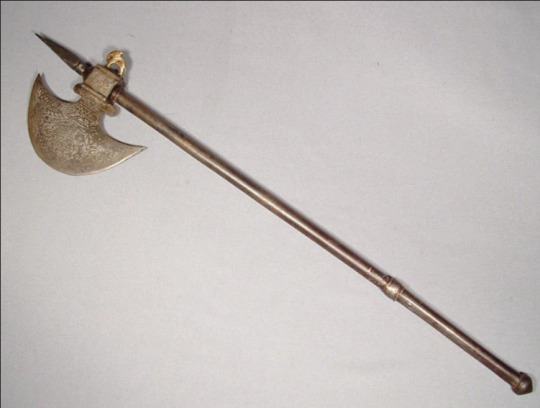
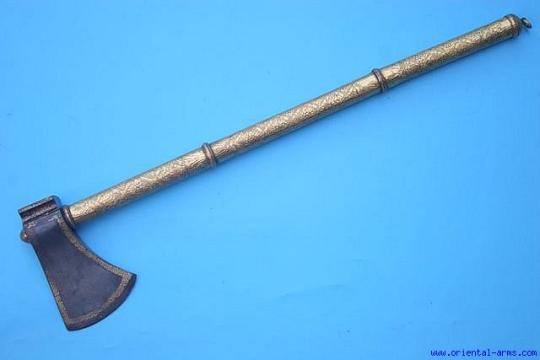
These included some of the few real-life examples of double-headed battleaxes (with daggers, but of course...)


Though popular in fantasy art, IRL usual practice was to have an axe on one side and something different like a hammer or pick on the other side in case the axe wasn't effective enough against whatever kind of armour the opponent was wearing.
And of course even single-headed axes often had the usual dagger tucked away.

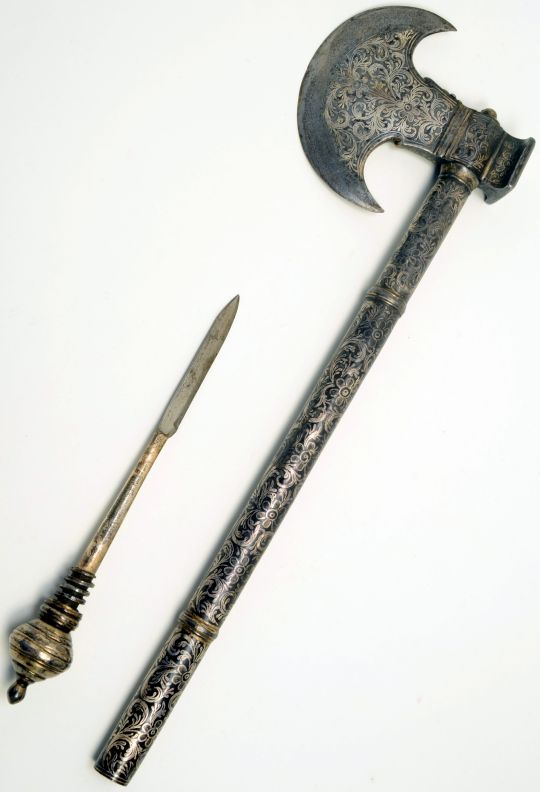
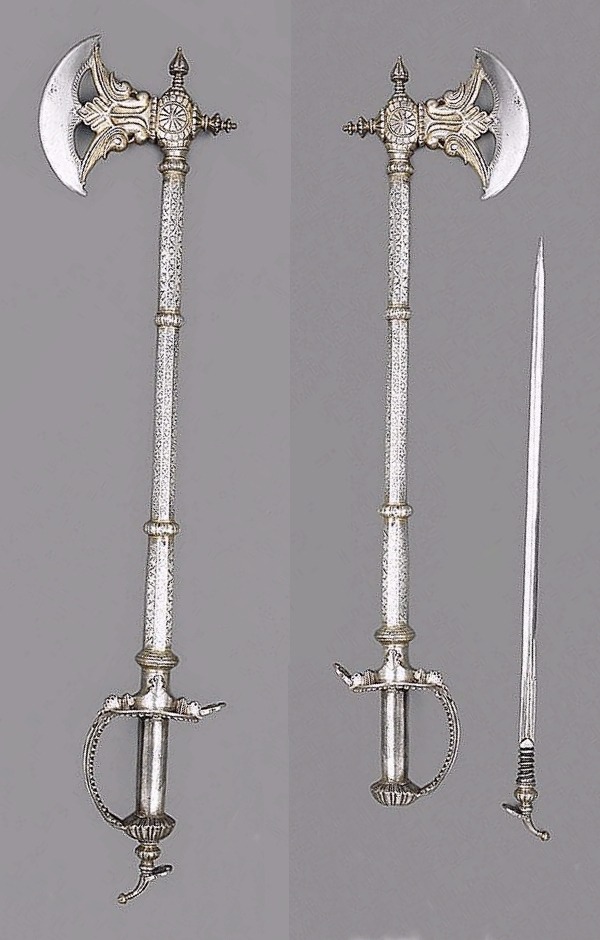
Here's yet another with a sword-hilt (also possibly a dagger) and a built-in matchlock gun...

And here's one where some warrior just couldn't make up his mind.

Here's a mace with a similar (khanda broadsword) hilt:

I took a close look at various mace-pics I've posted (here and here), something I should have done before, then searched further on-line, and I'm starting to think they had no daggers because mostly their hafts were solid rather than hollow...

Thanks go to @irlactualwizard for prompting me to track down an answer to my own question - though I'll be waiting for someone who knows far more about Indian weapons to correct me. :-P
Finally, here's a display case showing three more maces, a couple of the double- (here triple-) -bladed daggers called haladie, and a few examples of what Indian weaponsmiths could do with the basic concept of a sword blade...

...including making use of a European hilt, top row second left. Its blade may have been mounted on an Indian khanda or talwar hilt, which happened often enough to create a whole class of "firangi" (Frankish) swords.
There are many more pics on my blog and elsewhere. Once again, for fantasy edged-weapon inspirations, India is a great place to start...
:->
158 notes
·
View notes
Text
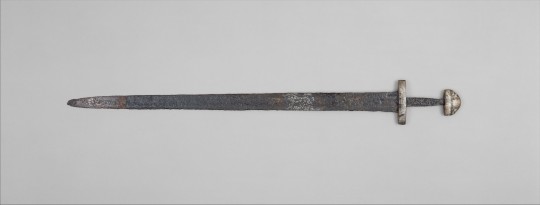
Viking Sword
European, probably Scandinavia, 10th century
The richly decorated hilt and pattern-welded blade indicate that this sword was carried by a warrior of high rank, perhaps a Viking chieftain or a Frankish nobleman. The braided copper wires on the pommel may represent an earlier Scandinavian custom of tying a protective talisman to a sword hilt. The pattern-welded blade was forged of intertwined rods of steel and iron, a technique that produced a tough yet resilient blade with a distinctive swirling pattern on its surface. Such blades were treasured for both their practical and decorative qualities.
42 notes
·
View notes
Text
A look at the etymology of the "arithmonyms" from the Locked Tomb series by Tamsyn Muir, arranged by difficulty level.
Easy:
-Deuteros = Ancient Greek δεύτερος (deúteros) "second"
-Dve = Pan-Slavic две/dvě "two"
-Tettares = Ancient Greek (Attic) τέττᾰρες (téttares) "four"
-Chatur = Sanskrit चतुर् (catur) "four"
-Pent = Ancient Greek πέντε (pénte) "five"
-Quinque = Latin quīnque "five"
-Sextus = Latin sextus "sixth"
-Hect = Ancient Greek ἕκτος (héktos) "sixth"
-Sex = Latin sex "six"
-Septimus = Latin septimus "seventh"
-Asht = Sanskrit अष्ट (aṣṭa) "eight"
-Oct = Latin octō "eight" or Ancient greek ὀκτώ (oktṓ) "eight"
-Nav = Sanskrit नव (nava) "nine"
Intermediate:
-Dyas = Ancient Greek (late medieval pronunciation) δῠᾰ́ς (duás) "the number two, couple, pair, diad"
-Tern = Latin ternī "three each, three at a time"
-Trinit = Latin trīnitās "the number three, triad, trinity"
-Tetra = Ancient Greek τετρᾰ́ς (tetrás) "the number four, the fourth day", or τετρα- (tetra-), prefixed form of τέττᾰρες (téttares) "four"
-Quinn = Latin quīnī "five each, five at a time", or quīn-, prefixed form of quīnque "five"
-Shodash = Sanskrit षोडश (ṣoḍaśa) "sixteen"
-Ebdoma = Ancient Greek (Koine pronunciation) ἑβδομάς (hebdomás) "a group of seven"
-Nonagesimus = Latin nōnāgēsimus "ninetieth"
-Novenarius = Latin novēnārius "containing or consisting of nine things"
-Novenary = Latin novēnārius (see above)
Advanced:
-Tridentarius = Neo-Latin tridēntārius "like a trident", from Latin tridēns "three teeth"
-Zeta = Sixth letter of the Greek Alphabet (although in Ancient Greek numerals it actually represents the number 7, because the original sixth letter was the now disused digamma)
-Heptane = Neo-Greek-Latin compound heptane, "saturated aliphatic hydrocarbon C7H16" (more literally "pertaining to the number seven, seven-like")
-Nonius = Latin Nōnius, a first name derived from the Nōnia plebeian family, ultimately from nōnus "ninth"
-Nova = Latin novem "nine" and/or nova "new" (it's been suggested that the Proto-Indo-European root *h₁néwn̥ "nine" is derived from the root *néwos "new")
Expert:
-Octakiseron = Ancient Greek ὀκτᾰ́κῐς (oktákis) "eight times" + unclear suffix, could have been constructed by analogy with -τερον (-teron, as in δεύτερον (deúteron) "second") and -μερον (-meron, as in ἑξαήμερον (hexaḗmeron) "six days"); alternatively based on or reinforced by the French diminutive suffix -eron, an extension of the diminutive -on (itself a merger of several Latin and Frankish suffixes), built by analogy with words like quarteron "quadroon" (from quartier "quarter, district" + -on); yet another possibility is Ancient Greek εἴρων (eírōn) "one who says less than they think, dissembler, pretender"
-Noniusvianus = not clear, perhaps a portmenteau of Latin Nōnius (see above) and noviēs "nine times", with an adjectival ending -(i)ānus.
-Nigenad = perhaps based on Proto-West Germanic *nigundō "ninth" (variant of the more common *neundō), or one of its descendants (Dutch negende, Middle English nyghend, West Frisian njoggende…); possibly reinforced by Old English nigonfeald "ninefold"
#the locked tomb#gideon the ninth#harrow the ninth#nona the ninth#arithmonym#etymology#tamsyn muir#linguistics#latin#greek#sanskrit#numbers#germanic#indo european#slavic#worldbuilding
231 notes
·
View notes
Text
image description by @swosheep
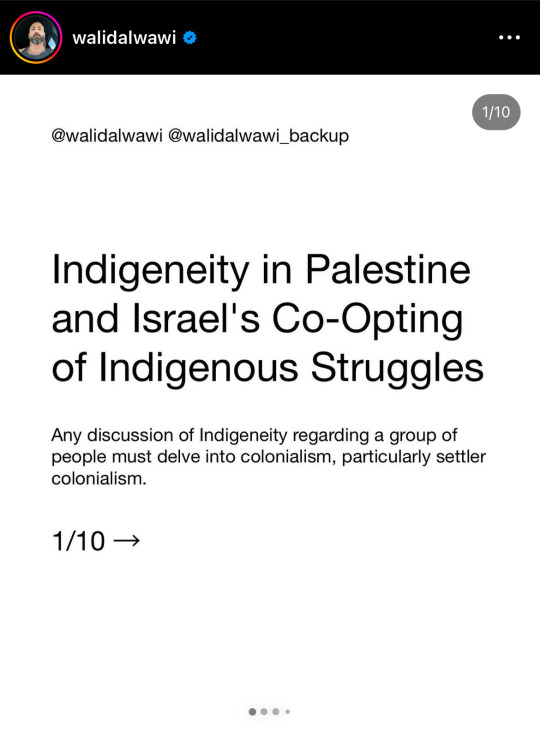
ID 1: All images are screenshots of a post made by walidalwawi on Instagram. They are all of black text on a plain white background. The first image is titled "Indigeneity in Palestine and Israel's Co-Opting of Indigenous Struggles" in large font. The body text, much smaller, reads: "Any discussion of Indigeneity regarding a group of people must delve into colonialism, particularly settler colonialism." Below the body text there is text reading: "1/10", with an arrow pointing left.
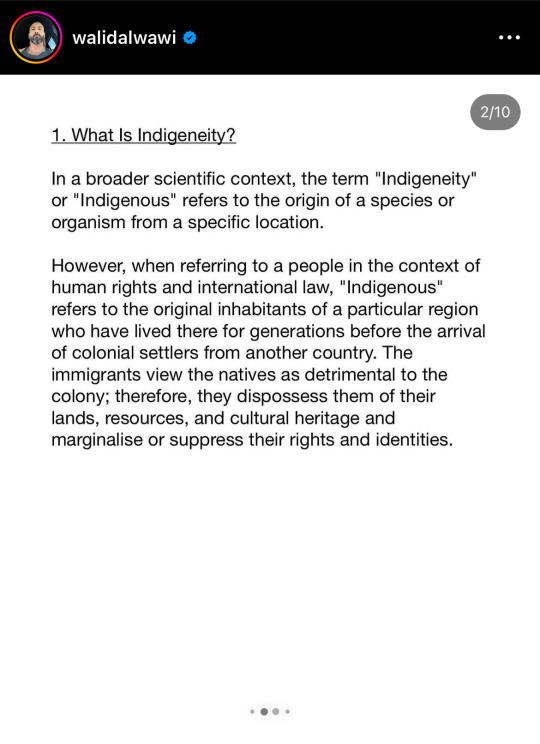
ID 2: The second image is titled: "1. What Is Indigeneity?" in underlined text. The body text reads: "In a broader scientific context, the term 'Indigeneity' or 'Indigenous' refers to the origin of a species or organism from a specific location. However, when referring to a people in the context of human rights and international law, 'Indigenous' refers to the original inhabitants of a particular region who have lived there for generations before the arrival of colonial settlers from another country. The immigrants view the natives as detrimental to the colony; therefore, they dispossess them of their lands, resources, and cultural heritage and marginalise or suppress their rights and identities."

ID 3: The third image reads: "In 2007, The UN formally recognised the rights of indigenous peoples by adopting the United Nations Declaration on the Rights of Indigenous Peoples (UNDRIP). The working definition of 'Indigenous Peoples': '…those communities, peoples and nations who, having a 1. historical continuity with pre-colonial and/or pre-settler societies that developed on their territories, consider themselves 2. distinct from other sectors of the societies now prevailing in those territories, or parts of them. They 3. form at present non-dominant sectors of society and are 4. determined to preserve, develop and transmit to future generations their ancestral territories, and their ethnic identity, as the basis of their continued existence as peoples…'"

ID 4: The fourth image reads: "Example of indigenous people: - First Nations, Inuit and Métis in Canada - Aboriginal and Torres Strait Islander people in Australia A group is not referred to as indigenous if they are not within or experienced a colonial power structure, even if they practically originate from their current locality, for example:
- Frankish People in France
- Anglo-Saxon Englishmen in the British Isles
- Dutch, Italians, Germans.
In face, Indigenous groups may cease to be referred to as indigenous if their colonial relation is dismantled. Thus, to Identify the Indigenous we must identify the coloniser as the two are often closely intertwined."
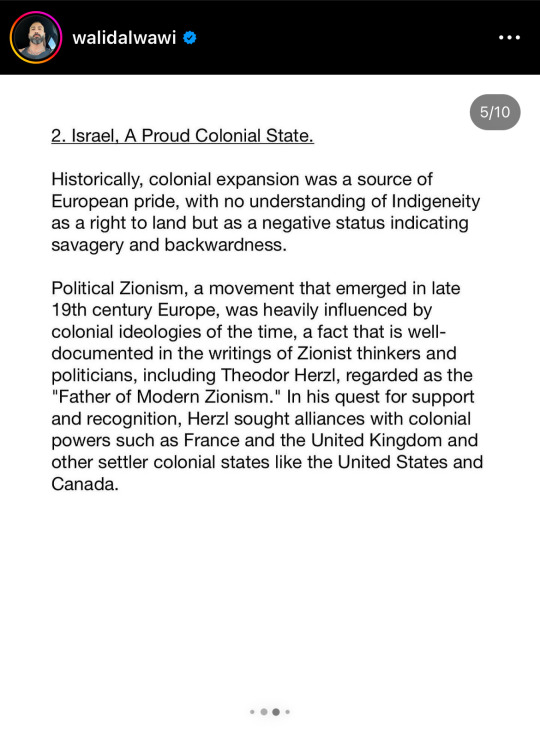
ID 5: The fifth image is titled: "2. Israel, A Proud Colonial State." In underlined text. The body text reads: "Historically, colonial expansion was a source of European pride, with no understanding of Indigeneity as a right to land but as a negative status indicating savagery and backwardness. Political Zionism, a movement that emerged in late 19th century Europe, was heavily influenced by colonial ideologies of the time, a fact that is well- documented in the writings of Zionist thinkers and politicians, including Theodor Herzl, regarded as the 'Father of Modern Zionism.' In his quest for support and recognition, Herzl sought alliances with colonial powers such as France and the United Kingdom and other settler colonial states like the United States and Canada."
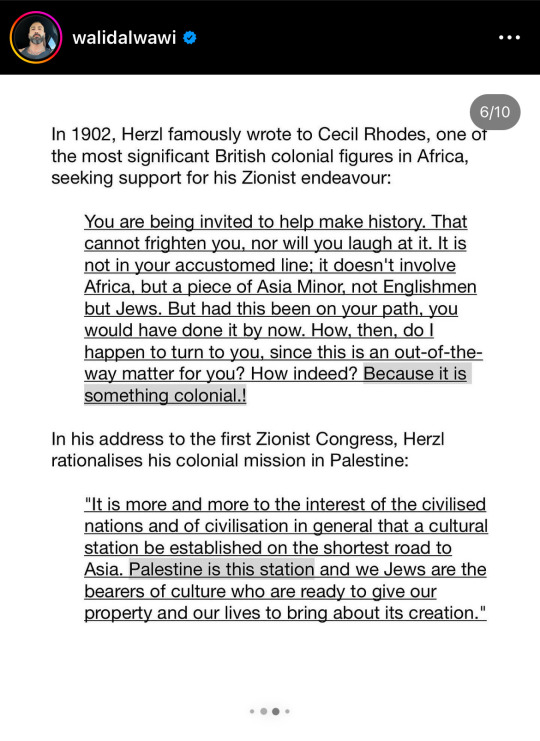
ID 6: The sixth image reads: "In 1902, Herzl famously wrote to Cecil Rhodes, one of the most significant British colonial figures in Africa, seeking support for his Zionist endeavour:". A block quote, all in underlined text, reads: "You are being invited to help make history. That cannot frighten you, nor will you laugh at it. It is not in your accustomed line; it doesn't involve Africa, but a piece of Asia Minor, not Englishmen but Jews. But had this been on your path, you would have done it by now. How, then, do I happen to turn to you, since this is an out-of-the-way matter for you? How indeed? Because it is something colonial.!" Body text continues: "In his address to the first Zionist Congress, Herzl rationalises his colonial mission in Palestine:". Another block quote with underlined text reads: "It is more and more to the interest of the civilised nations and of civilisation in general that a cultural station be established on the shortest road to Asia. Palestine is this station and we Jews are the bearers of culture who are ready to give our property and our lives to bring about its creation."

ID 7: the seventh image reads: "Jabotinsky, a Russian Jewish Zionist leader and founder of the Zionist terrorist organisation Irgun which helped establish israel. Wrote in his book The Iron Wall:". A block quote, all in underlined text, reads: "'Zionist colonisation must either be terminated or carried out against the wishes of the native population. This colonisation can, therefore, be continued and make progress only under the protection of a power independent of the native population an iron wall, which will be in a position to resist the pressure to the native population. This is, in toto, our policy towards the Arabs…' "'If you wish to colonise a land in which people are already living, you must find a garrison for the land, or find a benefactor who will provide a garrison on your behalf…. Zionism is a colonising venture and, therefore, it stands or falls on the question of armed forces.'" Body text continues: "This colonial history is not limited to the past, as we can see it vividly today in israel's colonial practice of daily oppression against the Palestinian natives."

ID 8: The eighth image reads: "Examples of standard methods used by settler colonies to oppress indigenous peoples: a. Land Theft and Dispossession: 1948, upon the establishment of israel, around 700,000 Palestinians were forced to flee or were expelled from their homes by israeli forces 1950, israel established the "Absentee Property Law", which allows the israeli government to seize control of land belonging to Palestinians who fled or were forced to leave during the 1948 war. b. Forced Assimilation: The "Judaization" of Palestinian neighbourhoods by promoting Jewish settlement and adopting Hebrew as the official language in education and public life while restricting Palestinian cultural expression, including banning books, films, and other media that are critical of israeli policies. E.g. The ban of the Palestinian flag in the occupied Gaza Strip and West Bank in 1967 and the prohibition of artworks containing the flag's four colours in 1980. c. Economical Exploitation: israel controls the majority of the water resources in the region as well as exploits Palestinian natural resources, including minerals, quarries, and agricultural land. Palestinian farmers have reported that israeli settlers have uprooted their olive trees, destroyed their crops, and polluted their farmland."
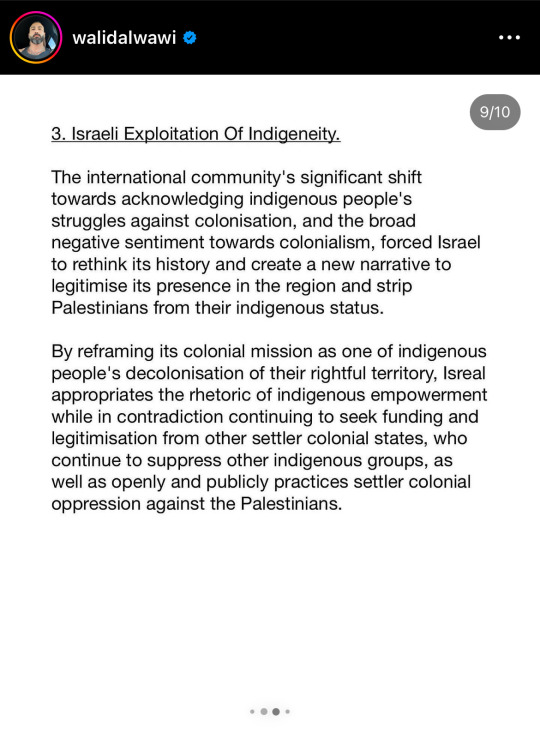
ID 9: The ninth image is titled: "Israeli Exploitation Of Indigeneity." in underlined text. The body text reads: "The international community's significant shift towards acknowledging indigenous people's struggles against colonisation, and the broad negative sentiment towards colonialism, forced israel to rethink its history and create a new narrative to legitimise its presence in the region and strip Palestinians from their indigenous status. By reframing its colonial mission as one of indigenous people's decolonisation of their rightful territory, israel appropriates the rhetoric of indigenous empowerment while in contradiction continuing to seek funding and legitimisation from other settler colonial states, who continue to suppress other indigenous groups, as well as openly and publicly practices settler colonial oppression against the Palestinians."

ID 10: The tenth image reads: "israel bases its argument on a supremacist ethno-nationalist and misleading definition of Indigeneity, claiming it to be an innate Jewish characteristic and not one imposed by colonialism. Such a claim severely harms indigenous groups on their mission to decolonisation by providing a legitimising framework for colonial tactics like ethnic cleansing, land theft and genocide to any group that claims ancestral ties to the land. Yet, even if one was to entertain the Zionist claim of Indigeneity through lineage, multiple genetic studies have already shown that many Jews and Palestinians share ancestry, rendering such claim unjustifiable, as the ethnically cleansed Palestinian are population shares the same ancestral history."
58 notes
·
View notes
Text
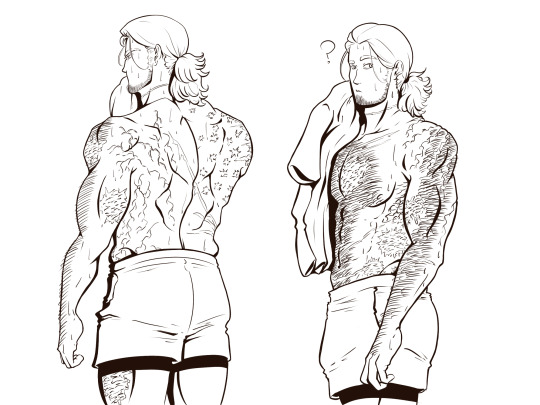

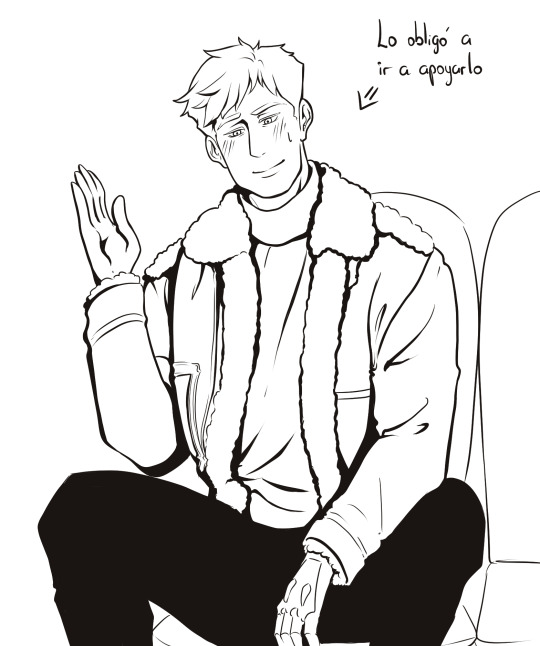
The military history of France encompasses an immense panorama of conflicts and struggles extending for more than 2,000 years across areas including modern France, Europe, and a variety of regions throughout the world.
According to historian Niall Ferguson, France is the most successful military power in history. It participated in 50 of the 125 major European wars that have been fought since 1495; more than any other European state. And has won 1115 battles in total, more than any in the world.
Source: Wikipedia, haha.
Well, this is my HC for France's body. I really do think he's no that different from Germany in constitution nor in height. They're brother nations, after all. At least Holy Roman Empire and him came from the same Frankish Empire, so. Yeah.
Also, in my HC, when there's no one looking, Francis has this very germanic frown, but when there's conscious social interaction, his galo-roman nature arise, haha! He has the best of both worlds.
And yes, this is FraPru. They're so underated.
And France is in rugby uniform, by the way. They won Rugby World Cup Sevens, congratulations!
29 notes
·
View notes
Text
Tamil
Wikipedia: https://en.m.wikipedia.org/wiki/Tamil_language
Excerpt: Tamil[b] (தமிழ், Tamiḻ, pronounced [t̪amiɻ] ) is a Dravidian language natively spoken by the Tamil people of South Asia. Tamil is an official language of the Indian state of Tamil Nadu and union territory of Puducherry, and the sovereign nations of Sri Lanka and Singapore. Tamil is also spoken by significant minorities in the four other South Indian states of Kerala, Karnataka, Andhra Pradesh and Telangana, and the Union Territory of the Andaman and Nicobar Islands. It is also spoken by the Tamil diaspora found in many countries. One of 22 scheduled languages in the Constitution of India, Tamil was the first to be classified as a classical language of India. Tamil is one of the longest-surviving classical languages in the world. A. K. Ramanujan described it as "the only language of contemporary India which is recognizably continuous with a classical past". The variety and quality of classical Tamil literature has led to it being described as "one of the great classical traditions and literatures of the world". Recorded Tamil literature has been documented for over 2000 years
French
Wikipedia:
Excerpt: French (français, French: [fʁɑ̃sɛ], or langue française, French: [lɑ̃ɡ fʁɑ̃sɛːz]) is a Romance language of the Indo-European family. It descended from the Vulgar Latin of the Roman Empire, as did all Romance languages. French evolved from Gallo-Romance, the Latin spoken in Gaul, and more specifically in Northern Gaul. Its closest relatives are the other langues d'oïl—languages historically spoken in northern France and in southern Belgium, which French (Francien) largely supplanted. French was also influenced by native Celtic languages of Northern Roman Gaul like Gallia Belgica and by the (Germanic) Frankish language of the post-Roman Frankish invaders. Today, owing to the French colonial empire, there are numerous French-based creole languages, most notably Haitian Creole. A French-speaking person or nation may be referred to as Francophone in both English and French. French is an official language in 27 countries and is spoken across all continents. French is also one of the most geographically widespread languages in the world, with about 50 countries and territories having it as a de jure or de facto official, administrative, or cultural language. Most of these countries are members of the Organisation internationale de la Francophonie (OIF), the community of 54 member states which share the official use or teaching of French. French is also one of six official languages used in the United Nations
16 notes
·
View notes
Text

So yeah, I started another TTRPG campaign with my friends on New Year's eve. This one will be (somewhat) alt-history-themed and will feature a lot of characters and events inspired by real-life counterparts.
The main premise is that the players will be Ottoman Empire janissaries during the wars with the Habsburgs. In addition to magic, there will be some DRAMATIC deviations from real-life history as in this timeline the "Unholy Reman Anarchy" has been overtaken by preachers of inhuman ideologies.
Since the main world for most of my projects humanizes the divine, I wanted to take a wholly different approach. Instead of humanizing the gods, in this new setting, I am planning to depict them as mostly unfriendly eldritch entities that can never be fully understood.
For session zero, I had the players play as pre-made characters who were fighting on the other side. The events in session zero took place 15-ish years before the main game and set up much of the main mysteries.
So, these four images represent, as follows:
Upper left: Wolfgang, leader of the First Violins, a Western European mercenary group that ended up getting destroyed during the Siege of Vienna. He was de facto the tutorial mentor for the players, introducing them to this new world.
Upper right: Maximillian, one of the warlords of the wild lands of the Unholy Reman Anarchy perished because of a Frankish betrayal in an incident that traumatized his young son, Otto.
Bottom left: Urban, preacher of Lucifer, a malicious light-themed deity said to have descended to earth and forced the Unholy Reman Anarchy to worship it a few decades ago. Urban has divested himself of all of his sensory organs in order to remain unwavering in his faith.
Bottom right: The Siege of Vienna also led to the demise of Yildirim's father, the sultan. As a result, she was forced to fight with her siblings to the death in order to succeed her father.
#art#fantasy#illustration#artists on tumblr#sketch#digital art#digital sketch#edgy art#dnd illustration#dnd character art#dnd npc#character design
33 notes
·
View notes
Text
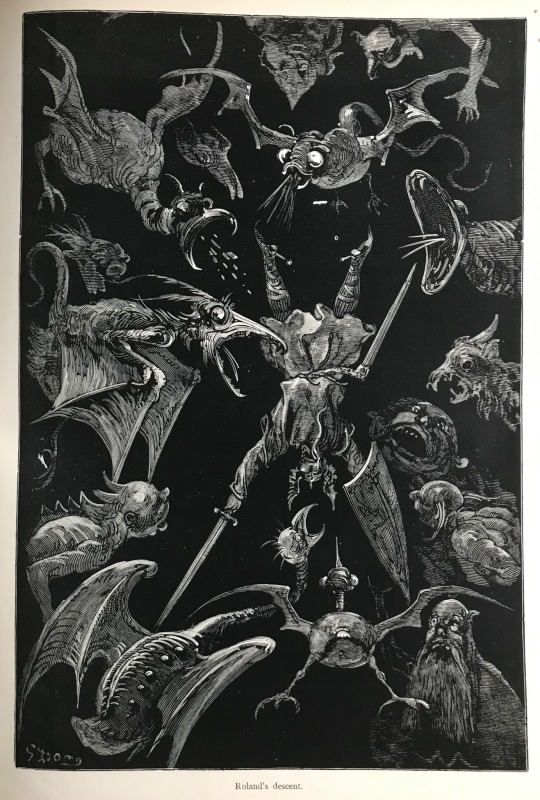
Roland's Descent (L'Épine's The Legend of Croquemitaine) by Gustave Doré
“The earth shook & gaped at Roland’s feet. He felt himself launched into space .. He heard around him the flapping of wings; it was a troop of afreets & djins.”
#roland#art#gustave doré#chivalry#chivalric romance#knight#knights#medieval#middle ages#franks#frankish#france#the legend of croquemitaine#history#paladin#mythology#ernest l'épine#ernest l'epine#french#germanic#europe#european#mythical creatures#monsters#afreets#jinn#djinn
120 notes
·
View notes